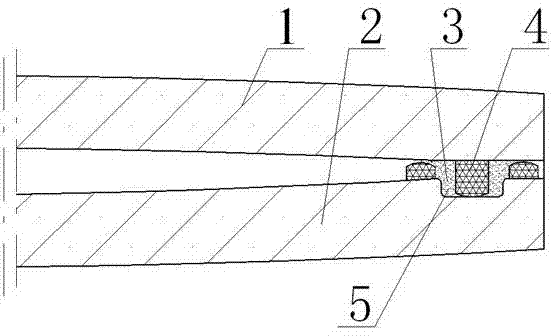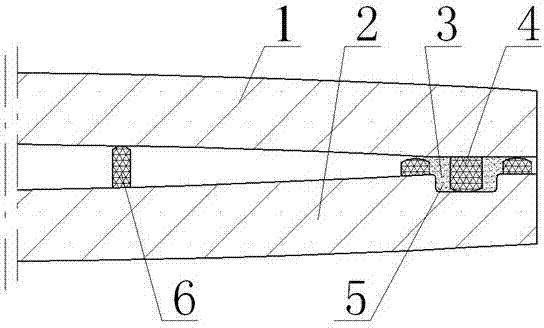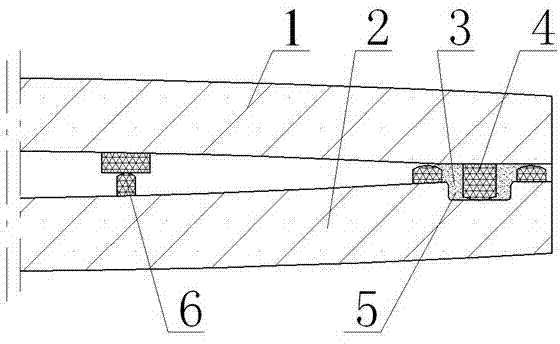Metal solder-microwave welded and strip frame-groove-edge-sealed convex vacuum glass and manufacturing method thereof
A vacuum glass and welding surface technology, applied in glass manufacturing equipment, glass production, glass molding, etc., can solve the problems of glass breakage, slow cooling speed, no convective heat transfer, etc., to increase the contact area and reduce tension Stress, transparency effect
- Summary
- Abstract
- Description
- Claims
- Application Information
AI Technical Summary
Problems solved by technology
Method used
Image
Examples
Embodiment 1
[0072] Embodiment 1: see figure 1 , the vacuum glass is composed of upper and lower pieces of glass, one of which is low-emissivity glass. Edge sealing grooves are opened at the welding place, and edge grinding, chamfering, cleaning and drying are carried out. On the upper and lower glass, the low-temperature glass powder paste is printed on the upper and lower glass to form an edge sealing strip frame. After the upper and lower glass are combined, the upper glass The edge banding strip frame can be embedded in the edge banding groove of the lower glass; print or spray commercially available silver paste on the position of the edge banding strip frame and the edge banding groove as a transition layer; secondly, put two pieces of glass into the mold, Put it in a hot bending furnace, heat up to the softening temperature of the glass at 550-750°C, rely on the gravity of the glass itself to make the glass downward to form a convex surface, and drop to room temperature with the fur...
Embodiment 2
[0075] Example 2: see figure 2 , one of the two pieces of vacuum glass is low-emissivity glass, and the other is tempered glass or half-tempered glass. For radiant glass, edge sealing grooves are set at the peripheral welding of the lower glass, and the edges are ground, chamfered, cleaned and dried, and the low-temperature glass powder paste is sprayed on the upper and lower glass with a spray gun to form an edge sealing strip frame, and the upper and lower glasses are combined. After sheeting, the edge banding frame of the upper glass can be fitted into the edge banding groove of the lower glass; after the upper and lower glass are dried, a layer containing low temperature The paste of glass powder is then printed or sprayed with a layer of commercially available silver paste as a transition layer; secondly, the upper glass is put into a mold, placed in a hot bending furnace, and heated to a softening temperature of 550-750°C, relying on the glass itself The gravity of the...
Embodiment 3
[0080] Embodiment 3: see image 3, the two pieces of glass of the vacuum glass are tempered glass or semi-tempered glass, one of which is low-emissivity glass, and its production method is as follows: first, a piece of flat glass and a piece of low-emission glass are cut according to the shape and size of the vacuum glass to be produced. , set up an edge sealing groove at the peripheral welding place of the lower glass, and perform edge grinding, chamfering, cleaning, and drying; use nylon screen to print low-temperature glass powder paste on the upper and lower glass to form an edge sealing strip frame, and combine the upper and lower glass Finally, the edge banding strip frame of the upper glass can be fitted into the edge banding groove of the lower glass; secondly, put the two pieces of glass into two forming molds respectively, the forming mold has an upper mold and a lower mold, and the glass is sandwiched Between the mold and the lower mold, and can apply pressure to cl...
PUM
| Property | Measurement | Unit |
|---|---|---|
| melting point | aaaaa | aaaaa |
| height | aaaaa | aaaaa |
| width | aaaaa | aaaaa |
Abstract
Description
Claims
Application Information
 Login to View More
Login to View More - R&D
- Intellectual Property
- Life Sciences
- Materials
- Tech Scout
- Unparalleled Data Quality
- Higher Quality Content
- 60% Fewer Hallucinations
Browse by: Latest US Patents, China's latest patents, Technical Efficacy Thesaurus, Application Domain, Technology Topic, Popular Technical Reports.
© 2025 PatSnap. All rights reserved.Legal|Privacy policy|Modern Slavery Act Transparency Statement|Sitemap|About US| Contact US: help@patsnap.com



